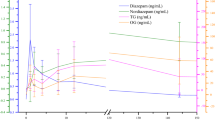Abstract
The objective of this paper was to determine how long after administration of benzodiazepine clonazepam (CLO), its major metabolite 7-aminoclonazepam (7-ACLO) could be detected in urine collected from 10 healthy volunteers who received a single 3-mg dose of Klonopin (clonazepam). Such data would be of great importance to law enforcement agencies trying to determine the best time interval for urine collection from a victim of drug-facilitated sexual assault in order to reveal drug use. A highly sensitive NCI–GC–MS method for the simultaneous quantitation of CLO and its major metabolite 7-ACLO in urine was developed and validated. The following urine samples were collected from each volunteer: one before CLO administration, and 6 h, and 1, 3, 5, 8, 10, 14, 21 and 28 days after. All urine samples (1 mL) were extracted following addition of the internal standard (D5-diazepam) and enzymatic hydrolysis (β-glucuronidase) using solid-phase extraction columns. Standard curves for CLO (500–4000 pg mL−1) and 7-ACLO (50–2000 pg mL−1) were prepared by spiking aliquots of negative urine. The urine from every subject was still positive for 7-ACLO 14 days after administration of the drug. Eight of the ten volunteers had measurable amounts of the metabolite 21 days after administration. One volunteer was still positive 28 days after administration. Six of the volunteers had urine concentrations of 7-ACLO that peaked at 1 day after administration. One volunteer had the highest concentration of 7-ACLO at 3 days, two volunteers at 5 days, and one at 8 days. The range of concentrations detected was from 73.0 pg mL−1 to 183.2 ng mL−1. CLO was not detected in any of the samples.








Similar content being viewed by others
References
Costa E (1983) The benzodiazepines: from molecular biology to clinical practice. New York, Raven Press
Schütz H (1982) Benzodiazepines: a handbook. Springer, Berlin Heidelberg New York
Browne TR (1976) Arch Neurol 33:326–332
Murdoch JK (1977) Can Pharm J 110:134–135
Müller WE (1987) The benzodiazepine receptor: drug acceptor only or a physiologically relevant part of our central nervous system? Cambridge University Press, Cambridge
Dowd SM, Strong MJ, Janicak PG, Negrusz A (2002) J Forensic Sci 47:1101–1107
Slaughter L (2000) J Reprod Med 45:425–430
ElSohly MA, Feng S, Salamone SJ, Wu R (1997) J Anal Toxicol 21:335–340
ElSohly MA, Feng S, Salamone SJ, Brenneisen R (1999) J Anal Toxicol 23:486–489
Cirimele V, Kintz P, Ludes B (1997) J Chromatogr B 700:119–129
Fitzgerald RL, Rexin DA, Herold DA (1993) J Anal Toxicol 17:342–347
Song D, Zhang S, Kohlhof K (1996) J Chromatogr B 686:199–204
Negrusz A, Moore CM, Stockham TL, Poiser KR, Kern JL, Palaparthy R, Le NLT, Janicak PG, Levy NA (2000) J Forensic Sci 45:1031–1040
Negrusz A, Moore CM, Hinkel K, Stockham TL, Verma M, Strong MJ, Janicak PG (2001) J Forensic Sci 46:1143–1151
Negrusz A, Bowen AM, Moore CM, Dowd SM, Strong MJ, Janicak PG (2002) J Anal Toxicol 26:471–478
Smit KM (1999) J Am Pharm Assoc 39:519–525
LeBeau M, Andollo W, Hearn WL, Baselt R, Cone E, Finkle B, Fraser D, Jenkins A, Mayer J, Negrusz A, Poklis A, Walls HC, Raymon L, Robertson M, Saady J (1999) J Forensic Sci 44:227–230
ElSohly MA, Salamone SJ (1999) J Anal Toxicol 23:141–146
Rickert VI, Wiemann CM (1998) J Pediatr Adolesc Gynecol 11:167–175
Kilpatrick DG, Acierno R, Resnick HS, Saunders BE, Best CL (1997) J Consult Clin Psychol 65:834–847
Calhoun SR, Wesson DR, Galloway GP, Smith DE (1996) J Psychoactive Drugs 28:183–189
Acknowledgments
This work was funded by the grant from the University of Illinois at Chicago Campus Research Board, Spring 2000 competition. The authors would like to thank medical personnel and staff of the University of Illinois at Chicago Clinical Research Center for help and dedication during the entire clinical study period.
Author information
Authors and Affiliations
Corresponding author
Rights and permissions
About this article
Cite this article
Negrusz, A., Bowen, A.M., Moore, C.M. et al. Elimination of 7-aminoclonazepam in urine after a single dose of clonazepam. Anal Bioanal Chem 376, 1198–1204 (2003). https://doi.org/10.1007/s00216-003-2050-7
Received:
Revised:
Accepted:
Published:
Issue Date:
DOI: https://doi.org/10.1007/s00216-003-2050-7




